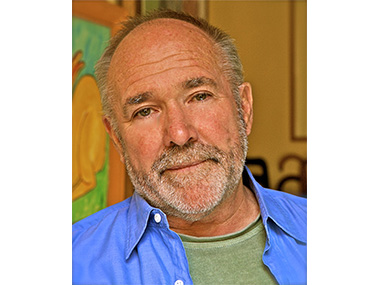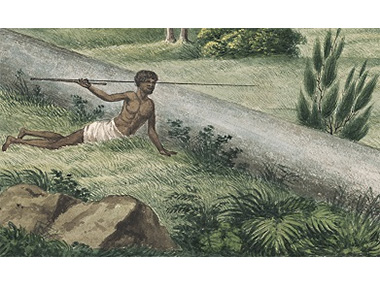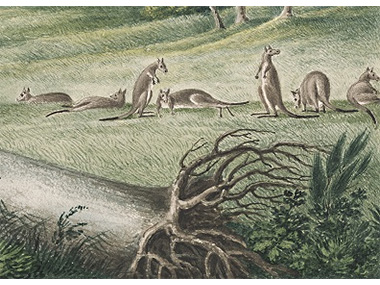Going Native in the Kitchen

Author Dr John Newton
Jeremy Eccles | 15.11.19
Author: Jeremy Eccles
News source: Review
John Newton is keen that we eat 'The Oldest Foods on Earth', ie Australian Indigenous foods, grown (sometimes cultivated), cooked and tasted here for up to 60,000 years. He's so keen that his 2016 book of that name on the history and beginnings of a commercial cuisine for native herbs and spices, fruit and vegetables, meat and fish has now been augmented – just in time for Christmas – by a collection of recipes.
Anyone for Magpie Goose Breasts? Or would you prefer Seared Kangaroo Loin, Wattleseed, Qandong and Warrigal Greens?
Newton, an acknowledged expert on the foods of Spain, isn't the first to develop this native enthusiasm. It was part of the anthropologists' practice going back to Spencer & Gillen to note the odd culinary habits of their subjects. And Newton makes the case for Ludwig Leichardt being a much smarter observer of those habits than Burke and Wills – who died from failing to note how certain seeds were treated before consumption; while Leichardt got the runs once from eating pandanus fruit and made sure he followed the locals' treatment of it next time.
Then came Jennifer Isaacs in 1987 with 'Bush Food' and herbal medicine – a half way house between the anthrops and now; folksy and descriptive with great images, but little expectation that these foods would turn up in Marrickville, North Adelaide or Eltham.
In a sense, Newton is operating in the tradition of recent breakthrough books by Bill Gammage and Bruce Pascoe which have established that colonial Australia wilfully ignored evidence plain before its eyes that Aboriginal cultivation of grasses and yams, for instance was widespread, and that much burning of the bush was not intended to make John Glover's paintings look more like an English park but to clear the brush for the easier hunting of macropods. And when the evidence of, say, a “prosperous town of a thousand on the banks of the Darling” was reported by the explorer Sturt, others, like the South Australian Surveyor Frome simply reported of a Coorong village of 24 houses that it was “burnt by me October 1840”! Both settlements would have required a controlled supply of food nearby in the form of fields, fish-traps, etc.
Desert life was a bit different, of course. And, fascinatingly, Newton reports on the anthropologist Richard Gould's year in the Gibson Desert in 1966/7 with Ngaanjatjarra people who appeared to him “so healthy”, until they were rounded up and taken into Warburton community. Their desert diet was primarily vegetable, provided by their gathering women, while the men came up with only 9% small game. Big game was only available after rain. But variety came from 38 different edible plant species and no fewer than 47 varieties of meat. That's a range from an old man roo to baby budgies! When the day's hunt yielded only a single goanna for two families, its mashed-up mix of guts and flesh gave each family member just a single mouthful augmented by a couple of tomato-like fruits.
And don't forget a wide variety of edible grubs!
Up in tropical Arnhemland, the Yolngu's eight seasons aren't all about the weather – they're about the foods that come with the changing season. Lots of underwater roots, and, of course, magpie geese.
And that reminds me of a magpie goose story that had two tellings. There was the early 20th Century reportage by Alice Duncan-Kemp in several volumes recalling her childhood in the Channel Country with her widowed mother and a reliance on Aboriginal help to run their property. Anthropologist Pamela Lukin Watson used those books and others from the Channel Country to theorise that the masculine versions were all about 'taming the land' (and people) while the women writers were respectful of and cooperative with the Karuwali tribe. So Watson reports the heart-rending scene where the rains have come and the creeks are full, a ceremony is held and, miraculously, the magpie geese arrive in flocks to nest beside the creeks. But now cattle also need that water, trampling all before them to get to it, so that “for months afterwards, a sticky mess of blood, egg yolk and albumen clung to the chests and legs of stock”.
What Watson, delicately, fails to report from the Duncan-Kemp original, is that the flock's arrival is initially, efficiently greeted by all of the tribesmen armed with multiple spears, stocking up on magpie geese for many months ahead!
In the here and now, John Newton reports the geese getting their own back by attacking NT mango orchards en masse....until a South Australian providore offered to work with the local Larrakia to emulate the Karuwali – using traps not spears - and put 3000 geese a year on to the market. Newton reckons it is the best poultry he's ever tasted, needing only a light searing of the breast meat and a little longer for the legs.
Of course, roo or wallaby is where you are likely to break your First Nations food duck. I know I did. And I reckon Indigenous TV chef Clayton Donovan's Kangaroo Loin smoked in Lemon Myrtle and served with a chocolate jus might be just the place to start! When I tackled my first barbequed roo, I was limited to the advice of Maggie Beer who convincingly believes that any wine marinade for the meat distorts the natural flavour of the kangaroo. So I wrapped my meat in just an olive oil coating plus 3 tsp each of mixed native pepperberries and juniper berries (bruised) and salt. The wine comes later as a much reduced glaze blended into butter, frozen and placed on top of the cooked meat.
Several chefs' recipes included by Newton seem to take the same line. But the author himself is a marinader.
'The Oldest Foods on Earth' and 'Cooking with the Oldest Foods on Earth' both come from New South Books.
URL: https://www.newsouthbooks.com.au/books/oldest-foods-earth-abridged-version/
Share this:
»  del.icio.us
»
del.icio.us
»  Digg it
»
Digg it
»  reddit
»
reddit
»  Google
»
Google
»  StumbleUpon
»
StumbleUpon
»  Technorati
»
Technorati
»  Facebook
Facebook
Contact Details

'Aborigines Hunting Kangaroos', the left half of the painting by Joseph Lycett, taken from John Maynard's study of the artist, 'True Light and Shade'

'Aborigines Hunting Kangaroos', the right half of the painting by Joseph Lycett, taken from John Maynard's study of the artist, 'True Light and Shade'
Further Research
News Tags: Alice Duncan-Kemp | Bill Gammage | Bruce Pascoe | Jennifer Isaacs | Jeremy Eccles | John Newton | New South Books | Pamela Lukin Watson
News Archive
- 19.11.19 | Re-imagining a museum of our First Nations
- 15.11.19 | Going Native in the Kitchen
- 10.11.19 | Emu Runner
- 05.11.19 | Cultural Momentum
- 29.10.19 | Warlimpirrnga Wins Copyright Claim
- 25.10.19 | It's Time for Tarnanthi
- 23.10.19 | Natives Go Wild
- 16.10.19 | Jandamarra: Sing for the Country : Ngalanyabarra Muwayi.u
- 14.10.19 | Impasse in Alice
- 02.10.19 | FIBRE ALCHEMY
- 27.09.19 | WE ARE COMING TO SEE YOU
- 19.09.19 | Mparntwe Muddles On
- 17.09.19 | Fondation Opale Glows Opalescent
- 13.09.19 | 'Mapa Wiya' (Your Map’s Not Needed)
- 08.09.19 | Sydney Goes Contemporary
Advertising

